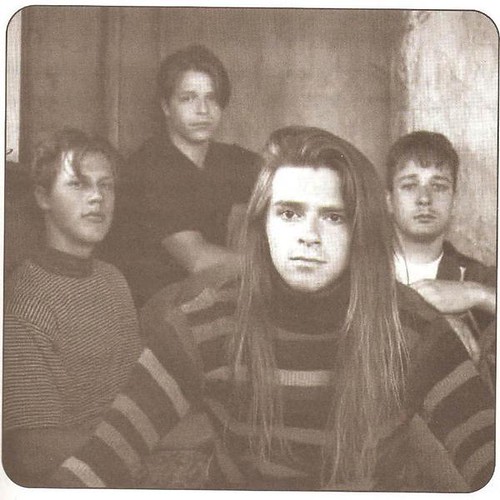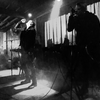With the spectre of grunge cowering in the corner, May 1994 saw the release of some solid alternative rock albums. Tapping into the gusto of their best years, Sonic Youth released their follow-up to Dirty, the Butch Vig-produced Experimental Jet Set, Trash And No Star; Frank Black yielded what remains to this day his solo peak, the twenty-two track masterstroke Teenager Of The Year, and the Beastie Boys released their second number one album on the Billboard charts, the critically-devoured Ill Communication. All well and good, but with indie rock's elder luminaries attempting to re-affirm their relevance, refusing to buckle and disappear in an era in full-blown transition, the seeds of a whole new alternative epoch were sown with Weezer.
Whilst certain corners would have us believe they arrived on the scene fully-formed, bursting with boundlessly infectious alt-rock anthems and inimitable geek-cool, Weezer (as pictured on the cover of their eponymously-titled debut album, aka The Blue Album) encountered the same growing pains that many less successful bands do. A quick case in point: glance between the almost knowingly hip indifference of the band on the cover of their Geffen-released debut with one of their very first promo photos, taken two years before.

The contrast is pretty remarkable.
Rivers Cuomo, with his long, dark hair, bears a stronger resemblance to, say, ex-Nirvana drummer Chad Channing, than he does the famously self-effacing character that Spike Jonze would masterfully capture in the videos for breakthrough The Blue Album singles, 'Undone - The Sweater Song' and 'Buddy Holly'. Then again, two years can be a very long time when you and your band are moving lightning fast.
Formed in February, 1992, the outfit that would eventually be called Weezer stemmed from the curiously-named 60 Wrong Sausages, featuring Cuomo, founding Weezer drummer Patrick Wilson, pre-The Blue Album Weezer guitarist Jason Cropper and Pat Finn, who can lay enviable claim to having introduced Cuomo to Wilson, founding Weezer bassist (and future Rentals' frontman) Matt Sharp and the band's "fifth member" Karl Koch. Veering precariously close to hair metal – which Cuomo had been playing in various outfits for a few years – the band disbanded before Cuomo and Wilson initiated "The 50 Song Project", a heady songwriting spree that would that produced several future Weezer classics including 'The World Has Turned and Left Me Here', 'Undone - The Sweater Song' and 'My Name Is Jonas'.
Fast forward a few months and Weezer, a newly-named four-piece, were starting to play the club circuit around Los Angeles. Whilst some appearances were memorable, the vast majority of them – in Cuomo's eyes at least – proved largely futile. Speaking about it later, he said, "Nobody would come to our shows, for months and months and months, and it seemed like forever. And I remember just being totally shocked at how little people responded to us, because I thought we were so good. I mean, we were playing the same songs that eventually became big hits, like 'The Sweater Song' and 'Say It Ain't So', and we'd play 'em out in the LA clubs and everyone would just be like, 'Go away, we want a grunge band.’" But Weezer didn’t budge.
Disillusioned yet driven in equally measure, Cuomo, Wilson, Sharp and Cropper persisted, playing a couple of DIY tours and generating a slow but steady buzz in and around L.A. Cut to a year later and with the obvious waning of grunge's one-time omnipotence, Weezer began to attract attention from a handful of labels. Having recorded a demo, The Kitchen Tape, in 1992 – a limited-run release featuring six tracks that would eventually be re-recorded for The Blue Album a year later – the band soon found themselves in a commanding position that they had been craving for what must have felt like forever and a day.
But by June, 1993, Geffen had signed Weezer, and Cuomo instantly felt conflicted about his role as a frontman in a major label band. Like many before him, for something that he had so desperately wanted the frontman was uncertain if the major game was the one for his band. Nonetheless, the penning of 'Holiday' and 'Buddy Holly' quickly followed and the band flew out to New York City in August, 1993 to commence the recording of The Blue Album with The Cars' Ric Ocasek. Having recorded the likes of 'Buddy Holly' (contrary to Cuomo's desire), 'No One Else', 'Surf Wax America' and 'Only In Dreams', things almost fell apart when Cropper was sacked mid-recording by Cuomo. A decision based on demanding 100% commitment from all members, the camp was in disarray before being revived by the arrival of Brian Bell of Carnival Art on lead guitar. In the space of no time at all, Weezer were signed, had lost a member, gained a new one and quickly finished recording their debut album.
Not unlike those first shows in L.A., the desired reaction wasn't exactly instantaneous. With the release of 'Undone - The Sweater Song' (a single that is right up there with the band's strongest cuts) Weezer had to disengage the suspicion that they were jokers. Though they certainly dabbled in the kooky and the deliberately eccentric, Weezer weren’t, nor felt, "gimmicky" as a band. They were steadfast and fully committed to getting their harmony-laden, guitar-driven alt-rock out to as many as possible. With 'Undone' laying the groundwork, it was 'Buddy Holly' – propelled by Ocasek's insistence they both record and release it as a single, as well Spike Jonze's Happy Days-themed video – that saw Weezer propelled to a fully-fledged, MTV-fuelled arrival. The band edged close to stratospheric and Cuomo, submerged in self-doubt, was quietly being torn apart.
"In the garage, I feel safe / No one laughs about my ways / In the garage where I belong / No one hears me / No one hears me sing this song."
Despite the ensuing cognitive dissonance, The Blue Album is, of course, nothing short of a flawless tour de force. Brimming with an embarrassment of hooks and glorious choruses, all underpinned by Cuomo's "everyday outsider" narrative, it distilled the more inward-looking mindset of every other college dorm the Western world over. From the blithe absurdity of 'My Name Is Jonas' to the album's crescendo-soaked closing overture 'Only In Dreams', Cuomo and co. forged self-conscious odes with huge power-pop, blazing solos with restless tangents informed by the likes of Brian Wilson, The Cars and KISS in equal proportion. Where 'Surf Wax America' and 'In The Garage' perfectly capture Weezer before the rot (that is: self-doubt, sameiness and, eventually, settling for mediocrity) set in, the album's third single 'Say It Ain't So' remains the band's quintessential single effort and a one-track précis of the sheer magic they unravelled in those formative years, not least on a first record that – particularly when viewed through the telling lens of retrospect – sounds just as fresh, commanding and downright ambitious as it did 23 years ago.























